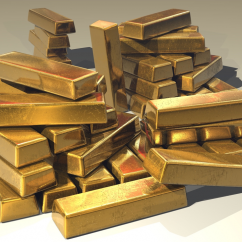Articles and News
What To Say When Customers Ask About Investing In Jewelry Or Precious Commodities | November 28, 2021 (0 comments)

New York, NY--Economic conditions in 2020 were volatile and, for many, dire. But as we know, jewelry sales did not suffer. Data from the United States indicates clearly that those who were less immediately affected by the financial fallout of the pandemic were inclined to buy more jewelry than usual last year, and the trend has continued into 2021.
There are various reasons for this, but among other things the trend indicates the stability of precious commodities –– including jewelry –– as investments. While for most people emotion is a bigger driver of jewelry purchasing than having an eye on financial futures, there is a level of comfort in buying items like these even in difficult times. There are people who do keep the long-term value of jewelry in mind when shopping, which comes from the fact that such items, by and large, tend to appreciate in value.
Related: Diamonds Or Mutual Funds? How To Have The Investment Conversation With Your Customers
With this in mind—and knowing that not all jewelry will appreciate at the same rate--we wanted to offer a few thoughts for those who do look at jewelry and other precious commodities as investments or as means of protecting wealth amidst the financial turmoil of the past two years. If your customers ask for your opinion in this regard, or if you've been considering alternative investments yourself, here's some basic information about how to invest safely. (Editor’s note: The following is for basic informational purposes only. The Centurion recommends you advise all customers to consult a trusted financial professional with experience in precious commodities before investing.)
Through commodity futures contracts. A guide to commodity futures contracts explains that these are agreements to buy or sell a raw material at a specific date in the future, for a particular set price.
Through a futures contract, the buyer makes money if the price of the underlying commodity goes up compared to the set price in the agreement. For instance, you can agree with the seller to buy silver at $10 in 5 years, and if in 5 years the price of silver goes up to $15, you’ll get $5 in return. However, should the price of the commodity go down, the seller will make money instead.
For a buyer, these contracts can ensure that the commodity purchased is at a fixed price, regardless if the market price is higher or lower. For sellers, this ensures that no money is lost, as they’ll still get the original agreed-upon price.
Through exchange-traded funds. An exchange-traded fund is a type of investment where assets are grouped together while passively tracking an underlying benchmark index, such as the S&P 500. You can think of this as a “basket” of securities with multiple assets like stocks, bonds, and gold — making them similar to mutual funds, with the flexibility of stocks.
It's an idea most commonly associated with gold as far as precious commodities go, and it is a smart way to diversify your portfolio with low risk. For one thing, gold ETFs don’t need to be physically stored; for another, you avoid being charged the premiums you would otherwise be charged for buying and selling physical bullion. There is also less risk involved, as you don't have to worry about buying the commodity from a reputable dealer.
Meanwhile, if you wish to tie an ETF to jewelry specifically, there are several out there that essentially bundle different varieties of luxury goods. The Amundi S&P Global Luxury (GLUX.MI) ETF for instance includes holdings in Richemont and LVMH, among other luxury goods brands.
Through buying shares in companies who produce or deal with commodities. Another popular way to invest in commodities is by directly purchasing shares of companies that produce and/or sell them. For instance, in jewelry specifically you can look into publicly traded companies like Tiffany & Co. (TIF) or Signet Jewelers Limited (SIG) or Berkshire Hathaway (BRK-A and BRK-B), with retail jewelry holdings like Ben Bridge, Borsheims, and Helzberg, and its supplier division Richline. For that matter, if you're looking to ride a trend of jewelry re-sale or creation, you might also consider an investment in a company such as Etsy (ETSY) to be an indirect play on the jewelry market.
One thing to note about investing in commodities this way though is that a given company won’t always reflect the rise and fall of the commodity it produces. A number of different factors having to do with company performance are in play. Nevertheless, this is certainly one more way to invest in precious commodities aside from direct purchase.
All in all, these are interesting methods to consider for anybody who's taken an interest in jewelry and fine goods markets for financial reasons, rather than purely as a consumer. The pandemic performance of products like fine jewelry clearly indicates the potential of exploring a stake in these markets' future.
Allie Young is a New York-based private investor and freelance writer focusing on finance, small business, fashion, and current events.







